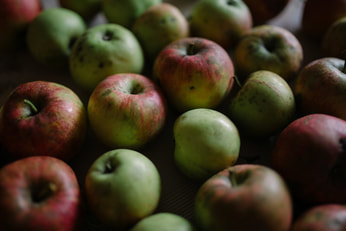 With a general explanation of FODMAPs and the human digestive system covered in Part 1, we have a great foundation set to allow us to move on and take a closer look at each of the FODMAPs specifically and where we commonly find them. Remember, FODMAPs = Fermentable Oligosaccharides Disaccharides Monosaccharides And Polyols Oligosaccharides Oligosaccharides are those carbohydrates with a few sugars linked together (Oligo = a few, saccharide = sugar). In the case of FODMAPs we are talking about a group called Fructans and a group called GOS. Fructans are made up of fructose (a type of sugar) units that are linked together in a chain. We commonly find fructans in grains like wheat, rye and barley and the products made from these grains. Fructans are also found in some fruits like dates and grapefruit and vegetables like onion, garlic and leek. Humans universally lack the enzymes required to break fructans down into small pieces and as discussed in Part 1 we need the contents of our food to be broken down into small enough pieces for us to absorb. Because fructans don’t get broken down they pass through the small intestine and into the large intestine where they are then fermented by bacteria. This process is thought to lead to the growth of more bacteria, primarily bifidobacteria and lactobacilli which are thought to have a range of positive effects in the body. Another byproduct of this fermentation is the production of short-chain fatty acids which are also thought to have positive impacts on human health ranging from improved cholesterol to potentially even effects on mental health. However, perhaps the most relevant byproduct for those with IBS is the production of gases such as methane, carbon dioxide and hydrogen. These gases lead to an increase in pressure in the intestines which can result in some of the common symptoms of IBS. The other oligosaccharides are GOS which stands for galactooligosaccharides. These are found in things like almonds, chickpeas and green peas. How these relate to FODMAPs is similar to the fructans in that humans universally lack the right tools (enzymes) needed to break these down into their simple sugars for absorption. In normal individuals and those with IBS there is the passage of these FODMAPs into the large intestine resulting in fermentation and gas production, the only difference is in those with IBS, in particular, they are more sensitive to these changes in pressure. We also know people with IBS tend to have more issues with moving contents of the gut which can also contribute to the symptoms as when these FODMAPs sit in the gut they tend to pull water in with them too. Disaccharides Disaccharides means two sugars joined together (Di = Two, Saccharide = Sugar). In the case of FODMAPs, we’re talking about lactose which is made up of one molecule of glucose and one of galactose. For lactose to be broken down adequately within the intestines humans must have sufficient amounts of the enzyme lactase. If we do not have enough lactase then lactose remains undigested and again moves through the small intestine and into the large, pulling in water and becoming fermented. It is thought about 10% of the New Zealand population is lactose intolerant, however the rates of lactose intolerance vary greatly between countries. The main sources of lactose are dairy products like milk, soft cheeses, some yoghurts and ice-cream. Things like hard cheese and yoghurt do have some lactose but are generally lower than other products due to the manufacturing process they go through, therefore even if someone has lactose intolerance they may be able to tolerate small amounts of these products. It should also be noted that even those with lactose intolerance have been shown to tolerate some lactose, all the way up to about 12-15g of lactose over the day. Monosaccharides Monosaccharides means just one sugar (Mono = One, Saccharide = Sugar). Concerning FODMAPs this is the sugar fructose and in particular excess fructose. The reason for this is fructose can be absorbed via two different channels, think of these as two roads that fructose can take to exit our intestines and enter our bloodstream. The name of these is GLUT 2 and GLUT 5 transporters. GLUT 5 transporter is specifically for fructose to use however fructose doesn’t like using it as it is slow. GLUT 2 is faster but for fructose to be allowed to use this road it has to share it with another sugar, glucose. Different foods will have these sugars in different ratios, therefore, if we have fructose in excess of glucose there isn’t enough glucose to accompany the fructose via the fast GLUT 2 transporter and so the remaining stuff has to try to go through the slow GLUT 5 transporter. This leads to malabsorption of the fructose as all of it can’t exit our small intestine before it gets moved down our gastrointestinal tract. Due to this, all the same things that happen to our other FODMAPs also happen (pulling in water and getting fermented to produce gas). Foods with excess fructose include apple, honey, mango, pear and asparagus. Polyols This group is also called our sugar alcohol group, containing sorbitol, mannitol, xylitol and maltitol. The main ones we are concerned about are called sorbitol and mannitol. These sugar alcohols are very slowly absorbed in the body by all people and so it is common for those with and without IBS to experience some gut upset from consuming them, particularly when consumed in excess. Polyols are often added to chewing gum or as artificial sweeteners in products, that is also why you will see on some of these products that consuming too much can have a laxative effect. We can also find polyols in some fruits and vegetables like avocado, apricot and mushrooms. Summary There are six main FODMAPs being Fructans, GOS, Lactose, excess Fructose, Sorbitol and Mannitol which are either universally or at least somewhat commonly not absorbed well by humans. This leads to water being pulled into the gut as well as acting as food for the gut bacteria in our large intestine resulting in fermentation and gas production, with the result being an increase in pressure in our intestines. These FODMAPs can be found in a range of foods from fruits, vegetables, legumes, grains, nuts and seeds and confectionery. Look out for part 3 which will cover what IBS is and how the low FODMAP diet is used in IBS. Thanks for reading. Marco
0 Comments
 Said “FOD-MAP” this is an acronym for Fermentable Oligosaccharides Disaccharides Monosaccharides And (yes - the A stands for And) Polyols. In English, they are a group of slowly absorbed or indigestible, short-chain carbohydrates. Even that is a little too long to say and so the people who pioneered this idea decided to shorten things down to the acronym FODMAP. One of the key attributes of FODMAPs is the fact they are poorly absorbed and move through our digestive system slowly which leads to two key things within the body. Before going into what those two things are it’s important we quickly touch on some basic human anatomy and physiology.  Our Internal Rollercoaster - The Digestive System A healthy digestive system is a crucial part of a healthy human body. It is where we absorb the goodness from everything we consume which we then use to keep our bodies moving and functioning well. Our entire digestive tract is a long tube spanning from our mouth to our anus with interconnected compartments. It could be thought of as a long winding roller coaster with different parts of the ride, some fast, some slow, some stops, and some places for people to get off throughout. Here’s what I mean. When we eat, food first passes into our mouth where we (hopefully) chew to begin the digestion process by physically breaking our food down. We then swallow and it quickly moves down our esophagus and into our stomach within seconds. Food will then stay in our stomach where it is exposed to secretions like acid and enzymes which help to break our food down. Also while stopping here food is being squished by the stomach as it contracts, which helps to mix our food with the stomachs secretions thus further helping to break it down. It is then fed into the small intestine which is where a lot of the magic (absorption) happens. Before our food is absorbed though it needs to be exposed to some more enzymes that are found in our small intestine. These enzymes help to break down the contents of our food into pieces that are small enough/suitable to be absorbed through the wall of our small intestine. Think of this as the roller coaster stopping and people exiting the ride because they have had enough. We absorb most of our nutrients through the small intestine and then the bits that don’t get absorbed pass into the large intestine. This is where we absorb a lot of our water as well as some of our electrolytes. It is also the home to the vast majority of our gut bacteria. As it passes through here losing water and electrolytes our gut bacteria also get fed with whatever has made it through to this part of the ride. Once through the large intestine, it is stored in our rectum before being expelled into the toilet. What does that have to do with FODMAPs? So why was that explanation of the digestive system so important? Well, as I was saying FODMAPs are poorly absorbed which means they don’t get off the ride when they’re supposed to (the small intestine) and instead stick around a little bit longer which causes a couple of things. Due to not being absorbed well these carbohydrates pull/hold water inside our intestine which can cause an increase in pressure in our gut. The other consequence is they pass through the small intestine and into the house of our gut bacteria - AKA the large intestine. Important to note here the F in FODMAP stands for fermentable, which in this case means these carbohydrates are able to be metabolized (eaten/broken down) by the microorganisms (like bacteria) in our intestine. This is great for our gut bacteria as they get to feast, generally, it’s also really good for us because we want to feed these gut bacteria, however, this is not so good for people with a sensitive digestive system, like those with Irritable Bowel Syndrome (IBS). With fermentation comes gas, with gas comes an increase in pressure in the tube that is our large intestine (think of someone blowing air into a balloon, your intestine is the balloon), and thus this can lead to some of the symptoms associated with IBS like abdominal pain, constipation, or diarrhea. This same increase in pressure occurs as a result of the FODMAPs pulling water into our intestines, again potentially leading to some gastrointestinal symptoms in those with a sensitive gut. Summary FODMAP is an acronym for a group of carbohydrates that don’t get absorbed well by humans. This is a normal thing and is often beneficial for our gut bacteria because it means they get to feast. However, a byproduct of them feasting is the production of gas and a consequence of these carbohydrates sticking around is they also hold more water in our gut. Both of these things can contribute to symptoms in people with a sensitive gut, such as those with IBS. Part two will be released next week breaking down each of the FODMAP groups and explaining where you find FODMAPs followed by part three which will go into IBS and the low FODMAP diet is more detail. For those who you have IBS and are feeling a little lost, confused or want more help get in touch today. Thanks for reading. Marco |
AuthorWrite something about yourself. No need to be fancy, just an overview. Archives
November 2020
Categories |
